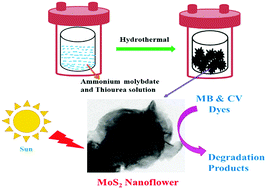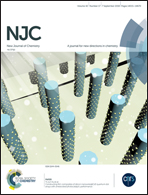Green synthesis of MoS2 nanoflowers for efficient degradation of methylene blue and crystal violet dyes under natural sun light conditions†
Abstract
Molybdenum sulfide (MoS2) is one of the most important layered semiconductors. Its importance arises because of its chemical, electrical and optical properties that lead to potential applications in fields such as photocatalysis, electrocatalysis, opto-electronics, etc. Here, we report a simple and novel green hydrothermal synthesis of MoS2 nanoflowers (NFs) from ammonium molybdenum hydrate and thiourea without using any acids or bases. The resultant MoS2 NFs have good crystallinity with a lattice spacing of 0.61 nm. The optical bandgap of the MoS2 NFs was found to be 1.55 eV. Photocatalytic degradation of methylene blue (MB) and crystal violet (CV) dyes with the MoS2 NFs under sun light irradiation was investigated. The MoS2 NFs showed excellent photocatalytic activity towards the degradation of MB and CV with almost 100% degradation with vigorous stirring under natural sun light. This is the fastest degradation of MB and CV dyes ever reported. This is faster than any other reaction performed by a photocatalyst under stirring and this is the first report on high degradation of CV by MoS2 NFs under natural sunlight. In addition to this, the MoS2 NFs displayed excellent repeatability.



 Please wait while we load your content...
Please wait while we load your content...